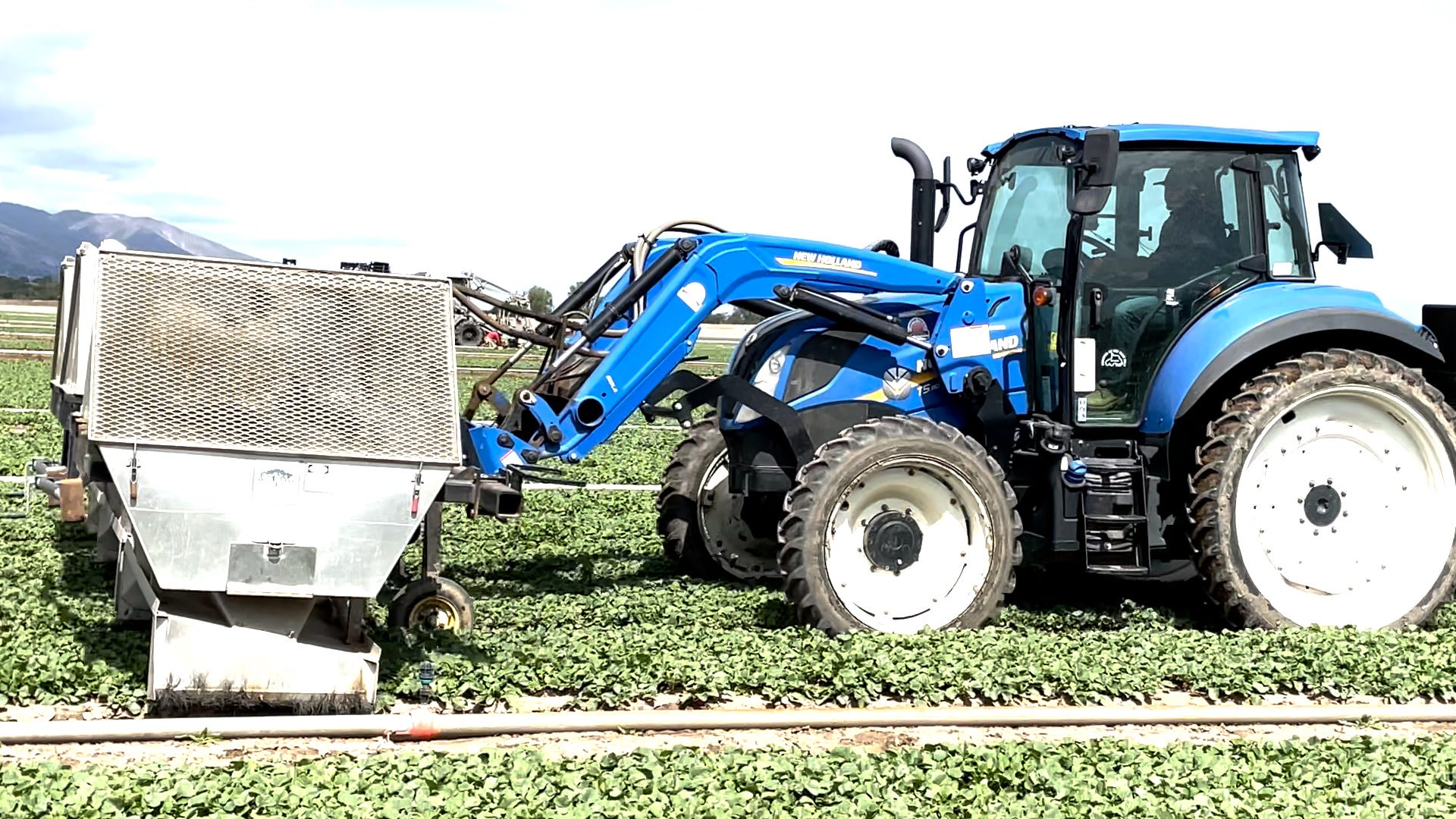
CHUALAR, Calif. – Looking like the ungainly combination of a Transformer and Edward Scissorhands, the robot slowly trundles across the field of tiny plants. It uses three high-resolution cameras to peer down at the ground below.
Lit by synchronized strobe lights, an onboard computer creates a digital image of each seedling as it glides by, comparing them with all the greenery it might reasonably find in a field of rich Salinas Valley farmland two hours south of San Francisco.
In a fraction of a second, there’s a match – broccoli – and the computer hones in on the exact center of the plant, creating an on-the-fly chart of its placement.
“It puts a dot on the stem and maps around it,” says Todd Rinkenberger of FarmWise, the robot’s maker. “Now it knows what’s plant. Everything else is a weed.”
The robot’s circular set of metal blades smoothly move so they’re right in front of the plant, then snick open and shut, precisely digging into the soil one on each side of the broccoli seedling, destroying the weeds while leaving the sprout untouched, ready to grow to harvest size in another month or so.
AGRICULTURE: Ancient farming practice makes a comeback as climate change puts pressure on crops
CLIMATE CHANGE: Weird weather hit cattle ranchers and citrus growers in 2022. Why it likely will get worse.
This all happens in a fraction of a second as the FarmWise Titan robot rolls down the field at less than 1 mile an hour.
“It’s been quite a change,” said Luis Vargas, who started out on 20-person weeding crews in high school and now runs a fleet of four robot weeders for Tanimura & Antle, a grower and seller of fresh vegetables in California and Arizona.
“I remember being in the hand crews, it would be 10 hours days walking the fields. When you get into a super weedy field it’s slow, it’s hard. And it’s hot,” he said. “These machines, they don’t care if it’s hot or cold.”
Farm robots could be good for human workers, farmers and the planet
The scene in Chualar is being played out in a small but growing number of fields nationwide as robots using machine learning are deployed. Today, automated machines are mostly driving tractors up and down fields, carrying loads and doing thinning and weeding. Other systems deploy precise doses of fertilizer or herbicides. But harvesting, especially delicate fruits and veggies, is further off in the future.
Together, machines are set to help solve a host of problems. The biggest is reducing the need for backbreaking agricultural jobs. Workers will still be needed, but more will be running the robots, fewer doing tedious, physical labor. It’s already resulting in a host of new jobs for people who can build, run and repair the systems. Community colleges and universities are busy creating programs to teach these skills to a new generation of agricultural workers.
Experts say agriculture is a rare application of cutting-edge technology that workers, tech companies, the government, and big business are all to varying degrees optimistic about.
READ MORE: Latest climate change news from USA TODAY
How does climate change affect you?: Subscribe to the weekly Climate Point newsletter
Another perk of robots, nonintuitive for people outside agriculture, is that they’re smaller and lighter than traditional large tractors. This means farmers can get working in fields early, when the ground is still too wet to bear the weight of large tractors and cultivators, giving farmers a longer growing season without worries about compacting and harming the soil.
“This is important especially with climate change because we’re expecting wetter springs and drier summers,” said Steven Mirsky, a research ecologist with the United States Department of Agriculture.
‘It’s a hard job’
Labor is a huge driver of the change, said John D’Arrigo, president of D’Arrigo California. His family has been growing lettuce, broccoli, cauliflower and broccoli rabe in California for three generations, and he sees his workforce aging out.
“We’re cutting 1 million heads of lettuce a day and it’s a hard job,” he said. “The people walking in the fields, bending over cutting lettuce? Those people are disappearing, they’re retiring,” he said.
Where there’s caution, it’s from unions that want to make sure their workers enjoy the benefits of automation and help decide how it’s rolled out. The United Farm Workers of America isn’t seeing robots displacing humans in the fields, said communications director Antonio De Loera-Brust.
Its biggest concern is that the technology be deployed to make agricultural jobs better, not make them go away.
“Is this going to be deployed to make farm work safer and take less of a toll on people’s bodies?” he said. “Or is this just going to be another tool to maximize profits on the back of farmworkers? We want workers to have a say in how robots get implemented.”
D’Arrigo says agriculture has to make its jobs better.
“I’m losing people to construction,” he said. “If we’re going to survive as an industry, we’re going to have to make jobs that are more lucrative and interesting.”
More: In San Francisco, the cars are driverless, the humans are baffled and future is uncertain
That’s certainly been the case for Vargas, 27. His mother has worked for more than 14 years in the packing sheds at Tanimura and Antle.
Vargas went to college with the goal of working in criminal justice, but the new tech possibilities intrigued him. He started working on the first demonstration Smart Cultivator robot systems from Stout Industrial Technology in Salinas about four years ago.
Today, the robot crews he manages can weed about an acre an hour.
“For a hand crew it would take about 20 people,” he said.
Farms are already more high-tech than you think
Agricultural robots and automated systems are mostly invisible to people driving by a field, said Emily Duncan, an agricultural technology and innovation researcher at the University of Guelph in Ontario, Canada.
That can be as simple as a tractor or combine that drives itself along a field of corn or wheat or soybeans. Called auto steer, these systems use GPS and only require that the driver turns at the end of the row.
“When you’re out harvesting 12, 13, 14 hours a day, driving for so long is really tiring. Using this, you’re mostly monitoring,” said Duncan.
As of this year, such systems are being used in more than 50% of row crops such as corn, soybeans, cotton and winter wheat, according to USDA.
The next level up will be machines that use high-resolution cameras to see each plant and give it a precisely measured squirt of fertilizer, depending on how well the plant is doing. If it’s puny, it might get more, if it’s nice and robust, then less.
In some cases, ag robots can do things that simply couldn’t be done before. One example is small robots that can navigate and weed under the canopy of a cornfield after the plants have grown high. Any weeds, even hidden ones, take nutrients and moisture from the soil that could go to crops.
“Now we just accept those weeds because we can’t get to them,” said Shadi Atallah a professor of agricultural economics at the University of Illinois Urbana-Champaign, where the robots are being developed.
Robots could also make organic foods cheaper. Today organic crops rely on more cultivation and hand work than conventional crops because herbicides can’t be used, which makes them more expensive to grow. Robots offer an alternative.
“Organic can mean having workers bending over t



